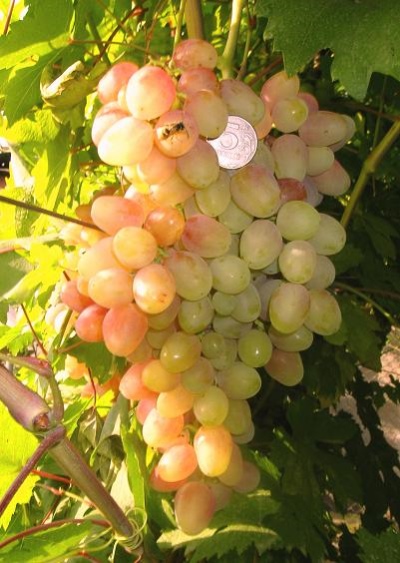
- Authors: Krainov Viktor Nikolaevich
- Berry color: pink
- Taste: harmonious
- With bones: No
- Ripening period: early
- Ripening period, days: 110
- Frost resistance, ° C: -23
- Bunch weight, g: 700-1500
- Flower type: bisexual
- Peeling: No
The hybrid grape variety Nakhodka is able to surprise winegrowers, and therefore does not lose its relevance. Agrotechnical conditions for its cultivation are simple, but require a careful approach. Culture itself hints at what it needs to maximize its harvest.
Breeding history
Nakhodka grapes were bred by an experienced enthusiast breeder V.N.Krainov, who instilled in him the best qualities of donors - Talisman and Luchisty varieties. The popular seedless grape Radiant endowed the novelty with its harmonious taste and good transportability, and the Talisman made it resistant to disease and frost.
Description
This hybrid belongs to the early ripening table varieties. Demonstrates good vine ripening, consistently high productivity.
Ripening period
Nakhodka grapes ripen by the end of August. The growing season is 110 days
Bunches
The bunches are conical in shape, rather weighty, the mass reaches 700-1500 g.
Berries
The berries are pink in color, each weighing about 7-8 g. All the grapes are selected, of the same color and level of ripeness. Seedless.
Taste
The taste is harmonious, the pulp is sweet, with a nutmeg tint and a noticeable sourness. Sugar content at the level of 18-21 g / l.
Yield
The variety is valuable for its high yield - up to 7 kg from each bush.


Growing features
Important stages in the development of the grape variety Nakhodka are the first 3 years, when maximum care of the plant is required.
Landing
Planting dates are not the same in different regions: in the south of the country - in spring-autumn, in central Russia and in the north - in the second half or at the end of May. It is important to take planting material from a responsible producer, a specialist winegrower, or to involve a familiar farmer in the choice. Choosing where to plant a vineyard requires careful consideration. It is worth giving preference to sunny areas on the south and southwest sides. Ideally - behind a wall or fence with an identical orientation in position.
The grapes grow well and bear fruit on fertile light soil. In the absence of such, it is possible to improve the existing ones at the expense of fertilizers. When planting, the groundwater level is taken into account - no closer than one and a half meters. Otherwise, drainage is required. In the selected place, planting holes are dug 1 x 1 meter in size at a distance of 1.5-2 meters between plants, and 2 meters between rows.

Pollination
The flower type is bisexual, self-pollinated.
Pruning
Fan-shaped bush formation is considered convenient for work: 4-6 sleeves of different lengths. They begin to form a seedling with 2-3 shoots from the first year. The grape bushes that are sheltered for the winter are pruned twice. Preliminarily - in the fall and finally - in the spring.

Watering
Nakhodka grapes are a drought-resistant crop. But a young vineyard needs regular watering. From a lack of moisture, adult plants are delayed with the formation of the crop. The growth of shoots and the accumulation of sugar also slow down with an excess of water. After each watering, together with weeding, a gentle loosening is performed.


Top dressing
The bushes are actively growing and need fertilizers for full development. The best organic fertilizer is compost containing elements such as nitrogen, phosphorus and potassium.
Frost resistance and the need for shelter
Withstands temperatures up to - minus 23 С (with shelter). Fallen foliage signals the need for pruning and shelter for the winter.

Diseases and pests
Experts assess the resistance of the variety to mildew damage at 3 points and give it a point less for susceptibility to gray rot. The variety requires preventive treatment and three times spraying, which increases resistance to fungal diseases: before and after flowering and after another 20 days.
A combination of contact and systemic fungicides is recommended, changing different mixtures, in order to avoid the addiction of pathogens.
Birds do some damage to the crop. Wasps are slightly damaged. Infusions of garlic, ash, a solution of laundry or tar soap, milk with iodine help to resist insect pests.

If a grape is exposed to any disease or insect, this always affects its appearance.
Storage
The bunches are removed before the onset of a sharp cold snap. Supercooled, and even more so frozen berries quickly deteriorate. Wet or overripe grapes are not stored. Periodically check and remove damaged berries. The crop is stored in a cool place, at t +5 degrees.
Review overview
The undoubted advantage of seedless grapes Nakhodka selection by Krainov is its high marketability.
The bush reacts painlessly to improper pruning.
The cold-resistant grape Nakhodka became widespread geographically, and its excellent taste made it one of the favorites of winegrowers.











































































